A Guide to Tracing Your Mayo Ancestors Dedication To the memory of my father
Oliver Smith
1925-2009 A Guide to Tracing Your Mayo AncestorsBrian Smith First published in 1997
First published in 1997
Second Edition 2010 Flyleaf Press
4 Spencer Villas
Glenageary
Co. Dublin, Ireland
www.flyleaf.ie 2010 Flyleaf Press British Library cataloguing in Publications Data available ISBN 978-0-9563624-3-8 All rights reserved. No part of this publication may be reproduced, stored in a retrieval system, or transmitted, in any form or by any means, electronic, mechanical photocopying, recording or otherwise without the prior permission of the copyright owner. The information in this book is subject to change without notice. Cover Illustration:
Eoin Ryan
www.eoinryanart.com Layout:
Brian SmithAbbreviations Used
| aka | also known as |
| APMDI | Association for the Preservation of the Memorials of the Dead in Ireland |
| Arch. | Archaeological |
| A.R.P | Acres Roods Perches |
| b. | birth/born |
| bapt. | Baptism |
| BELB | Belfast Education and Library Board |
| BL | British Library |
| BNL | British Newspaper Library |
| Bo. | Barony |
| c. | circa |
| Co. | County |
| CoI | Church of Ireland |
| d. | death/died |
| ed. | editor/edited (by) |
| DCLA | Dublin City Library and Archive |
| DCPL | Dublin City Public Libraries |
| DHG | Dublin Heritage Group |
| DKPRI | (Reports of the) Deputy Keeper of Public Records of Ireland |
| DLGS | Dun Laoghaire Genealogical Society |
| DLHS | Dun Laoghaire Heritage Society |
| DU | Dublin (Diocese) |
| Dublin Hist. Reg. Reg. Sect. | Irish Memorials Assoc. Parish Register Section |
| IMC | Irish Manuscripts Commission |
| Ir. | Irish |
| Ir. Anc. | Irish Ancestor |
| Ir. Gen. | Irish Genealogist |
| J. or Jnl. | Journal |
| JAPMD | Journal of Association for the Preservation of Memorials of the Dead |
| J. Soc. Soc. I. | Journal of Genealogical Society of Ireland |
| LC | Local Custody |
| LDS | Latter Day Saints (Family History Centre) |
| Lib. | Library |
| Lon. | London |
| MCL | Mayo County Library |
| m. or marr. | marriage/married |
| mf. | microfilm |
| MNFHRC | Mayo North Family History Research Centre |
| Ms/Mss | Manuscript/s |
| NAI | National Archives of Ireland (formerly PRO) |
| n/a | not available/none available |
| n.d. | not dated |
| Nee | Formerly |
| NLI | National Library of Ireland |
| N or Nth. | North |
| OP | Official Papers |
| p./pp. | page/pages |
| PHSI | Presbyterian Historical Society of Ireland |
| Pos. | Positive (microfilm) |
| PRO | Public Record Office (now National Archives of Ireland) |
| PRONI | Public Record Office of Northern Ireland |
| Pub. | published/publisher |
| RC | Roman Catholic |
| RCB(L) | Representative Church Body (Library) |
| RIA | Royal Irish Academy |
| RSAI | Royal Society of Antiquarians in Ireland (J. of) |
| SMFHRC | South Mayo Family History Research Centre |
| SLC | Family History Library, Salt Lake City (and branches) |
| Soc. | Society |
| SOG | Society of Genealogists (London) |
| SPO | State Paper Office |
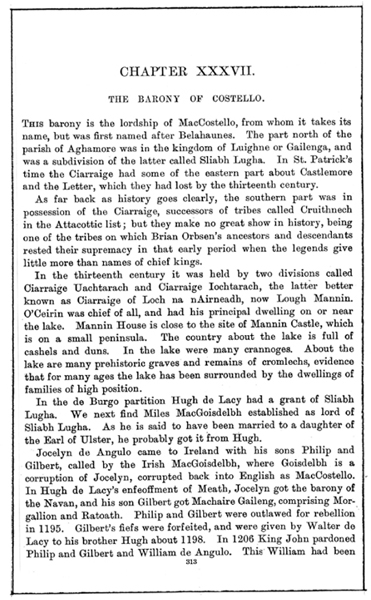 A page from The History of County Mayo to the Close of the 16th Century by Herbert Thomas Knox, Dublin (1908)
A page from The History of County Mayo to the Close of the 16th Century by Herbert Thomas Knox, Dublin (1908) Chapter 1 Introduction Mayo is situated on the northwest coast of Ireland and is the second largest county in the province of Connaught, covering an area of 1.3 million acres. It is bordered by Sligo, Roscommon and Galway. The major towns of Mayo are Castlebar, Crossmolina, Ballinrobe, Ballina, Killala and Westport and the current population is 123,829, a drop of 215,058 since the 1841 census of Ireland. The landscape varies from relatively flat land in east Mayo, through large island-studded lakes, like Loch Conn, Loch Carra and Loch Mask to the naked quartzite peaks along the Atlantic coast.
This coast has both rugged cliffs and sandy beaches. North Mayo has extensive tracts of blanket bog and some good agricultural land, while south Mayo is more mountainous. It is a county with many scenic landscapes and has a rich archaeological and historical heritage. It is a popular tourism county with amenities of interest to the naturalist, family historian and sportsman alike. Although picturesque, the land is mainly poor, much of the land is bog or mountain. Although Mayo was probably first inhabited around 7000 BC, the earliest evidence is from the fourth millennium BC.
In this, the Neolithic period, the first farmers arrived introducing agriculture, animal husbandry, pottery-making and weaving skills. Around 160 megalithic tombs were built by these people. The earliest surviving architectural structures in the country, are in Mayo. As this is over 10% of the total number of such tombs found in all of Ireland, the Mayo region was clearly of importance during the Neolithic period. It retained this importance into the Bronze Age (c.2000-400BC) when this phase of tomb-building came to an end. The blanket bog which covered parts of Ireland from the late 3rd Millennium BC onwards also covered, in some places, the field systems, habitation sites and tombs of these early farmers.
Extensive pre-bog field-systems with stone walls have been discovered embedded in the bog in many parts of Mayo. The Behy/Glenulra region, west of Ballycastle in County Mayo, contains a 1,500 hectare archaeological site of this type, known as the Cide Fields. This is the most extensive Stone Age monument in the world. County Mayo got its name from a diocese of that name which evolved from a 7th century monastery of Maigh Eo, established by Saint Colmn. The Irish name Maigh Eo, meaning plain of Yew trees was later anglicised to Mayo. When the county was established by the English around 1570, it was called Mayo after this monastery and diocese.
The families of county Mayo are a mix of native Gaelic, Norman and immigrant Gaelic from Northern Ireland. There is also a small number of other immigrants from other places. The major original Gaelic inhabitants included the families of Gallagher, Moran, OMalley and Duffy. From the 12th century, there was also the Norman occupation of the county, in particular by the families of Burke, Barrett and Walsh. The 16th century sectarian struggle in Northern Ireland resulted in the enforced migration of many thousands of Catholics to Mayo. These migrants were settled as tenants on several of the major estates in the county.
The county was predominantly involved in agriculture and fisheries and had few industries. In 1798 the Irish rebelled against English rule and Mayo became the battleground for one of the major events of that war. The French General Humbert and 11,000 men landed at Killala to assist the Irish Rebels. This army was defeated after a brief campaign, significant imprisonments and land confiscations in the county resulted. Sources and records of this period are detailed in Chapter 13. 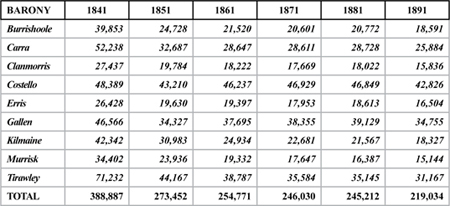
Next page
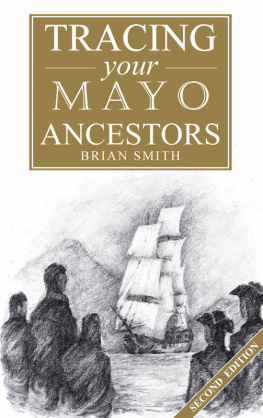
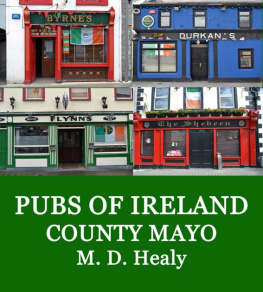
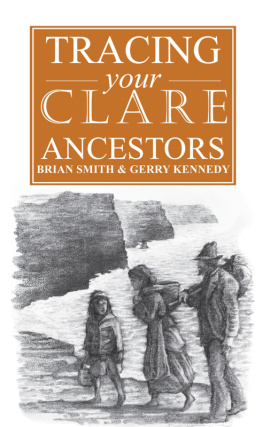
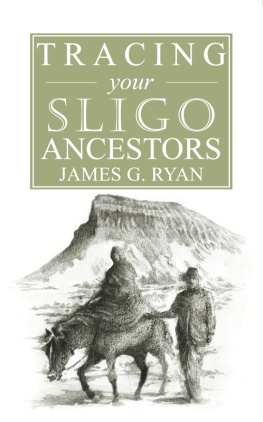
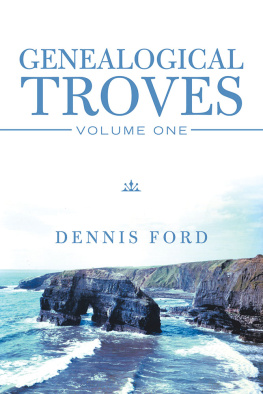
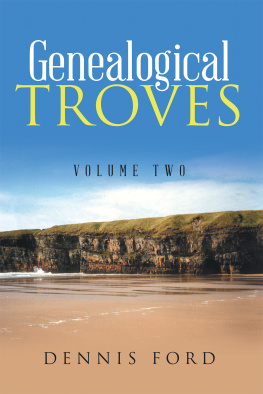
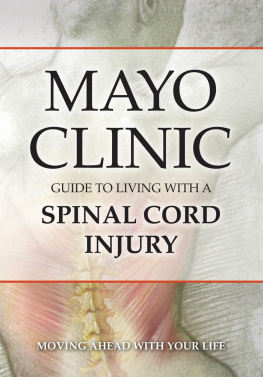

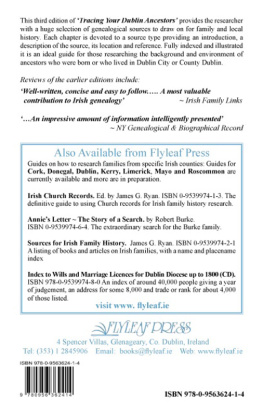
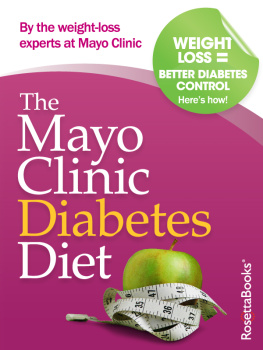
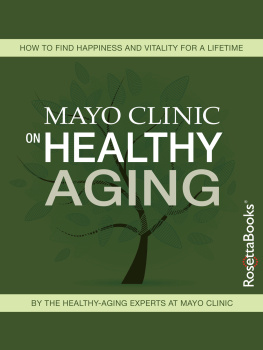
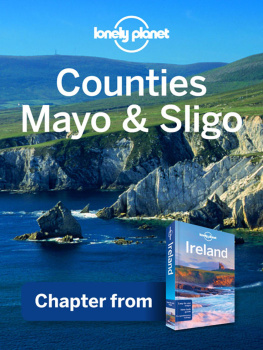
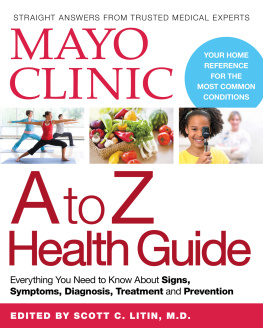
 First published in 1997
First published in 1997 A page from The History of County Mayo to the Close of the 16th Century by Herbert Thomas Knox, Dublin (1908) Chapter 1 Introduction Mayo is situated on the northwest coast of Ireland and is the second largest county in the province of Connaught, covering an area of 1.3 million acres. It is bordered by Sligo, Roscommon and Galway. The major towns of Mayo are Castlebar, Crossmolina, Ballinrobe, Ballina, Killala and Westport and the current population is 123,829, a drop of 215,058 since the 1841 census of Ireland. The landscape varies from relatively flat land in east Mayo, through large island-studded lakes, like Loch Conn, Loch Carra and Loch Mask to the naked quartzite peaks along the Atlantic coast.
A page from The History of County Mayo to the Close of the 16th Century by Herbert Thomas Knox, Dublin (1908) Chapter 1 Introduction Mayo is situated on the northwest coast of Ireland and is the second largest county in the province of Connaught, covering an area of 1.3 million acres. It is bordered by Sligo, Roscommon and Galway. The major towns of Mayo are Castlebar, Crossmolina, Ballinrobe, Ballina, Killala and Westport and the current population is 123,829, a drop of 215,058 since the 1841 census of Ireland. The landscape varies from relatively flat land in east Mayo, through large island-studded lakes, like Loch Conn, Loch Carra and Loch Mask to the naked quartzite peaks along the Atlantic coast. 